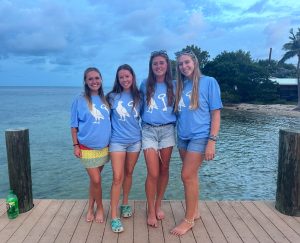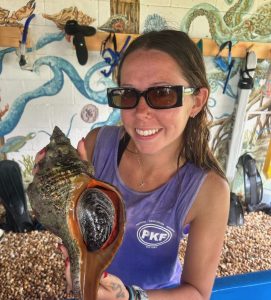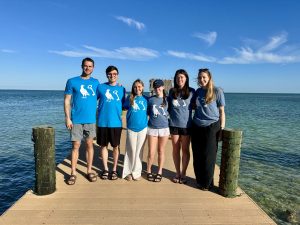The animal kingdom is abundant in adaptations that work to hide, conceal, and confuse using tactics as simple as adhering an unassuming sponge to one’s back. Enter: the sponge crab! Our 2019 Marine Science Education season on Pigeon Key has been the year of the sponge crab, and for this newfound abundance and respect we have formed for such a unique little creature, I present to you an interesting tale of a crab and his search for the perfect sponge.
Within the infra order true crabs’, Brachyura, Florida and the Caribbean are home to two species of sponge crab: Antilles (Cryptodromiopsis antillensis) and Redeye (Dromia erythropus), where the Antilles are notable for their long white eyestalks (ommatophores) and the Redeye have spines to the side of their eye and along their lateral margin. Off the shores of Pigeon Key, we find ourselves running into Redeye Sponge Crabs left and right, under rocks where they hide out until dusk. As nocturnal feeders, our nocturnal tidepooling with visiting school groups has proven fruitful in procuring these small crabs while they’re out and actively fetching food. And, of course, this arthropod’s most interesting characteristic is its carefully cut and shaped sponge!
Researchers in Japan investigated the relationship a crab develops with sponges: the selection, the formation, and the crafting involved in developing a new, portable shelter. Various sizes of plain foam sponges were provided to several crabs and filmed. After hours of observing the hat-making process, researchers found all sponge crabs to have an amazing sense of self-awareness for their size and body shape, carefully tailoring and fitting a sponge, only to take the sponge off and continue alterations. Crabs continued this trial and error effort until they found the perfect fit, finalizing their ‘caps’ which they then adhere to their back (carapace) and hold in place with two rear legs modified for this purpose. As long as a sponge is capable of being molded, scientists found the crabs held no real preference for any specific sponge species; however, the sponge of choice may provide not only camouflage for the delicate Dromiidae (the taxonomic classification for the sponge crab family), but often additional chemical defenses such as toxins.
So what about the sponge? An animal itself, the sponge continues its life as a simple filter-feeder while riding on the back of a crustacean! The relationship doesn’t appear to be especially beneficial for the sponge, but who doesn’t enjoy a free backpacking trip now and again–especially if you’re the backpack! Come check out these cute critters next time you’re tide pooling around Pigeon Key by checking under rocks and keeping your eyes peeled for walking sponges!
By Holley Maassen, 2019 Education Intern



